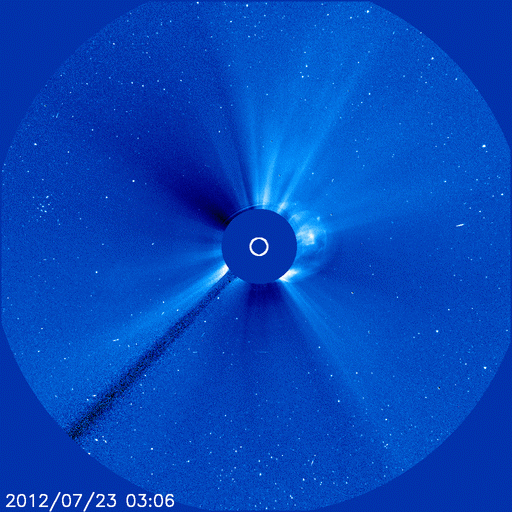UPDATE, 3:30 p.m.: NOAA’s Space Weather Prediction Center (SWPC) just posted the following:
The R3 (Strong) Radio Blackout today at 12:49 EDT (1649 UTC) was accompanied by an earth-directed CME. Hampered by limited observations of the event, SWPC forecasters are now anticipating the passage of the [coronal mass ejection] around 1:00 a.m. EDT, Saturday, July 14. G1 (minor) Geomagnetic Storm activity is expected to then ensue through the rest of the day.
In short, NOAA is predicting minor effects from this space weather event - no major impacts on the power grid or satellites anticipated - although we remind you forecasting space weather is difficult and surprises are possible. Sky watchers in northern U.S. (and high latitudes) may have an opportunity to see aurora late Friday night into early Saturday morning.
Original post, from 2:30 p.m.: A massive sunspot region facing Earth - known as 1520 - has unleashed a large solar flare. NOAA’s Space Weather Prediction Center says the flare is rated an X1.4. This type of flare is considered “strong” and can cause a blackout of high frequency radio communication on the sunlit side of Earth for one to two hours.
It is not yet known whether the flare was accompanied by a coronal mass ejection (CME) - an outburst of particles that can trigger a geomagnetic storm on Earth and damage the electrical grid.
Joe Kunches of NOAA’s Space Weather Prediction Center in Boulder said one of the NASA satellites tasked with watching for solar weather, SOHO, was “on maneuvers” when the flare launched.
That will make the task of predicting the course of any subsequent CME more difficult.
“The home plate umpire wasn’t paying any attention,” said Kunches.
But two other NASA sun-facing satellites, STEREO A and B, were watching.
“It’s now up to the first and third base umpires to see if it crosses home plate” – meaning Earth, Kunches said.
UPDATE, 2:35 p.m.: NASA’s Goddard Space Weather Center said a CME has occurred with the flare. No additional information is yet available.
In addition to possible effects on the power grid, geomagnetic storms can disturb Earth-orbiting satellites and produce aurora - mainly at high latitudes, but into the mid-latitudes if they are strong enough.
The X-flare emitted by the gigantic sunspot region falls within the class of biggest solar flares. M-class flares are medium-sized and C-class flares are smaller.
Within each class of flares, there additional size divisions.
For example, X-flares are rated 1-20 (and higher). The present flare, an X1.4, is at the bottom of the scale. So while this is a large, strong flare, it’s not the same as an X20 flare, considered extreme.
"Discovered in 1986, Comet 96P/Machholz is a fascinating comet that has passed through SOHO coronagraph images four times now," says Karl Battams of the Naval Research Lab. "It's not a huge comet but it is very photogenic, and puts on quite a display with its beautiful dusty tail."
In an essay posted on his web site, Battams explains why the comet is so fascinating. Many researchers suspect 96P/Machholz is not a native of our solar system; some chemical evidence suggests it came from another star. Also, 96P/Machholz appears to be dynamically related (that is, the comet's orbit is related) to a diverse collection of other objects in the solar system including asteroid 2003 EH1 and the Quadrantid, Southern Delta Aquariid, and daytime Arietid meteoroid streams. All of these things--the asteroid, the comet, and the meteoroids--might be fragments of a single "foreign" body that broke apart thousands of years ago.
Comet 96P/Machholz will be visible in SOHO coronagraphs until July 17th. Battams believes the comet will reach a peak brightness of 2nd magnitude--not its best show. "But who knows," he says, "maybe Comet Machholz will do something completely and utterly unexpected like fragment into a swarm of Machholzlets." Join SOHO for a ringside seat.


 Re: SOHO LASCO C2 Latest Image
Re: SOHO LASCO C2 Latest Image

 Re: SOHO LASCO C2 Latest Image
Re: SOHO LASCO C2 Latest Image

 July 12th, 2012
July 12th, 2012

 Re: SOHO LASCO C2 Latest Image
Re: SOHO LASCO C2 Latest Image



 Re: SOHO LASCO C2 Latest Image
Re: SOHO LASCO C2 Latest Image

 Re: SOHO LASCO C2 Latest Image
Re: SOHO LASCO C2 Latest Image
 Re: SOHO LASCO C2 Latest Image
Re: SOHO LASCO C2 Latest Image

 Re: SOHO LASCO C2 Latest Image
Re: SOHO LASCO C2 Latest Image

 But a Slow CME
But a Slow CME slowcme_strip.jpg
slowcme_strip.jpg 
 Re: SOHO LASCO C2 Latest Image
Re: SOHO LASCO C2 Latest Image
 Re: SOHO LASCO C2 Latest Image
Re: SOHO LASCO C2 Latest Image

 Re: SOHO LASCO C2 Latest Image
Re: SOHO LASCO C2 Latest Image
 Re: SOHO LASCO C2 Latest Image
Re: SOHO LASCO C2 Latest Image

 Re: SOHO LASCO C2 Latest Image
Re: SOHO LASCO C2 Latest Image

 Re: SOHO LASCO C2 Latest Image
Re: SOHO LASCO C2 Latest Image

 Re: SOHO LASCO C2 Latest Image
Re: SOHO LASCO C2 Latest Image

 Re: SOHO LASCO C2 Latest Image
Re: SOHO LASCO C2 Latest Image
 Re: SOHO LASCO C2 Latest Image
Re: SOHO LASCO C2 Latest Image

 Re: SOHO LASCO C2 Latest Image
Re: SOHO LASCO C2 Latest Image

 Re: SOHO LASCO C2 Latest Image
Re: SOHO LASCO C2 Latest Image

 Re: SOHO LASCO C2 Latest Image
Re: SOHO LASCO C2 Latest Image

 Re: SOHO LASCO C2 Latest Image
Re: SOHO LASCO C2 Latest Image

 Re: SOHO LASCO C2 Latest Image
Re: SOHO LASCO C2 Latest Image
 Re: SOHO LASCO C2 Latest Image
Re: SOHO LASCO C2 Latest Image
 Re: SOHO LASCO C2 Latest Image
Re: SOHO LASCO C2 Latest Image